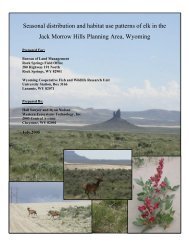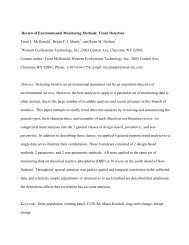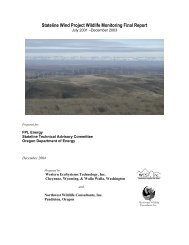Jackson Hole Pronghorn Study - WEST, Inc.
Jackson Hole Pronghorn Study - WEST, Inc.
Jackson Hole Pronghorn Study - WEST, Inc.
You also want an ePaper? Increase the reach of your titles
YUMPU automatically turns print PDFs into web optimized ePapers that Google loves.
OBJECTIVES<br />
The objectives of this study were intended to provide the necessary information<br />
to develop a conservation strategy for pronghorn that summer in GTNP and the GVRD.<br />
1) Identify the specific travel route(s) used by pronghorn during spring and fall<br />
migrations.<br />
2) Identify potential bottlenecks or barriers that may threaten migration routes.<br />
3) Determine the extent of the winter range(s) used by the <strong>Jackson</strong> <strong>Hole</strong> population and<br />
fidelity to winter range(s).<br />
4) Determine extent of fidelity of pronghorn to GTNP and GVRD summer range(s).<br />
5) Determine affect of spring weather conditions and snowpack on spring migration<br />
patterns.<br />
6) Estimate survival rates of radio-collared pronghorn.<br />
STUDY AREA<br />
The study area was defined by pronghorn distribution in GTNP and the GVRD<br />
(Fig.1). This included Baseline Flats, the Potholes, south Antelope Flats, and the Kelly<br />
hay meadows in GTNP. Small groups of pronghorn were occasionally found outside<br />
GTNP in the Uhl Hill and NER areas. Gentle slopes and large homogenous stands of<br />
sagebrush (Artemisia sp.) between 6,600-7,000 feet (2,011-2,133 m) characterized<br />
most pronghorn habitat in GNTP. <strong>Pronghorn</strong> often shared these sagebrush habitats<br />
with elk (Cervus elaphus), bison (Bison bison), and a variety of potential predators<br />
including coyotes (Canis latrans), wolves (Canis lupus), red fox (Vulpes fulva), and<br />
Golden eagles (Aquila chrysaetos).<br />
Compared to GTNP, pronghorn habitat in the GVRD was more steep, rugged,<br />
and at higher elevation. Most pronghorn occupied areas on the north side of the<br />
GVRD, between Upper Slide Lake and Bacon Ridge. The south facing sagebrush<br />
slopes of the upper GVRD ranged from 7,200-8,800 feet (2,194-2,682 m). Although<br />
pronghorn in the GVRD were usually found in or near sagebrush habitats, they also<br />
utilized areas of secondary succession in burns and mesic mountain meadows that<br />
may exceed 9,100 feet (2,774 m). Refer to Loope (1971), Sabinske and Knight<br />
(1978), Mattson and Despain (1985), Love and Love (1988), Schroeder and Allen<br />
(1992), Whitlock (1993), and/or Doyle et al. (1998) for detailed descriptions of the<br />
vegetation, climate, and geology of GTNP and the GVRD.<br />
3









